This guide on what to see in Athens, Greece includes the famous Athens landmarks, as well as neoclassical buildings, Byzantine churches and Ottoman buildings in Athens.
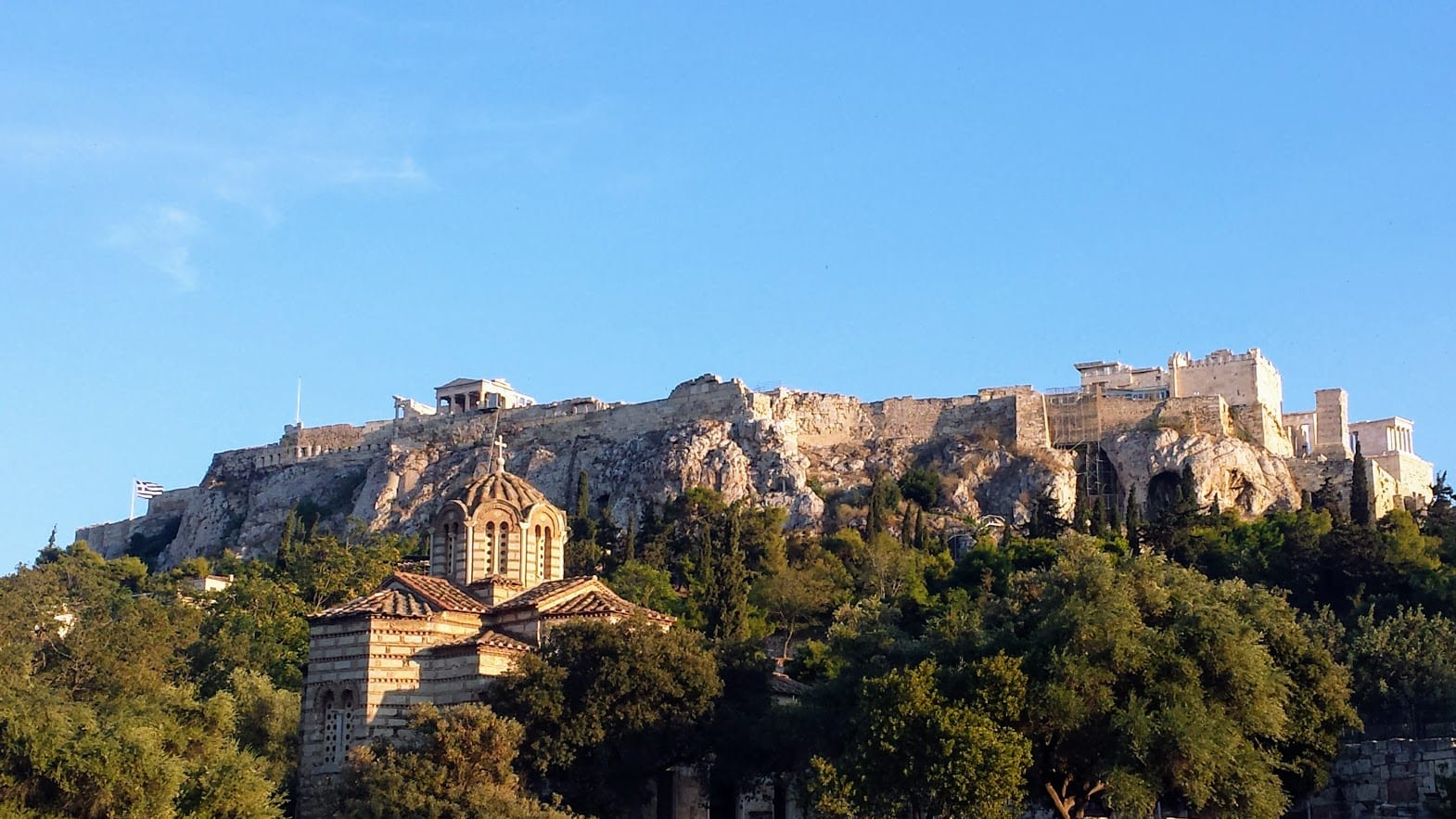
Landmarks and Attractions in Athens
Most people planning a trip to Athens know that the Acropolis is one of the main things to see, but trust me, there is so much more to the city!
Having lived in Athens for nearly five years now, I’ve had the chance to visit all the major landmarks of Athens, and more than a few which fly under the radar.
Now, it’s time to share the love so you can experience Athens like I have.
This city guide covers all the main places to see, as well as some unusual places to visit in Athens.
I’ve also created this list of what to see in Athens in some sort of chronological order in terms of building construction dates, along with a potted history of Athens.
Consider this guide as a starting point to planning your trip to Athens.
If it all sounds too much, and you’re more interested in specific itineraries on what to do in Athens, I’ve got those for you as well. Take a look here:
And you can always sign up for my free travel guides to Athens and Greece for yet more information:
With the introductions out of the way, let's leap in to this Athens guide!
Ancient Athens Landmarks
Many visitors are aware of Greece’s ancient past, and are excited to visit the most famous archaeological sites in Athens, like the Acropolis and the Acropolis museum.
What many people don’t realize, however, is that Athens has been through several different eras that followed from the time of “Ancient Greece”.
The latter is really the Classical era, which only lasted for about 150 years, and led up to the Roman era.
The exact dates of transition between two eras are widely disputed upon. Very roughly speaking, those eras are:
- Classical era (5th – 4th century BC)
- Hellenistic era (4th – 1st century BC)
- Roman era (1st century BC – 3rd century AD)
- Early Byzantine era (3rd – 5th century AD) and Byzantine era (5th – 13th century AD), during which there were several invasions by people from the north (Heruli, Goths, Vandals, Slavs, Saracens)
- Latin era (13th – 15th century AD)
- Ottoman era (15th – 19th century AD), during which there were attacks by the Venetians
- Neoclassical era (19th – 20th century AD)
While the most famous monuments were built in the Classical and Roman eras, Athens is full of other buildings, especially churches built during the Byzantine era, but also some Ottoman and neoclassical buildings.
Related: What is Athens famous for?
Walking through history in Athens
Although most of the ‘ancient' buildings in Athens are located in the historic centre, other such as the neoclassical buildings can be found in different areas. You might find my guide to the neighbourhoods in Athens useful in order to get your bearings.
This blog post on things to see in Athens is one of the biggest on my blog. As such, I've put an index below, where you can jump through to areas that interest you the most.
Athens Buildings and Landmarks
Classical/Hellenistic/Roman Athens
Almost all of the most famous Athens attractions date from this era. You can find details of the most significant below.
The Acropolis of Athens
There's no denying that perhaps one of the most famous landmarks in Greece is the Acropolis.
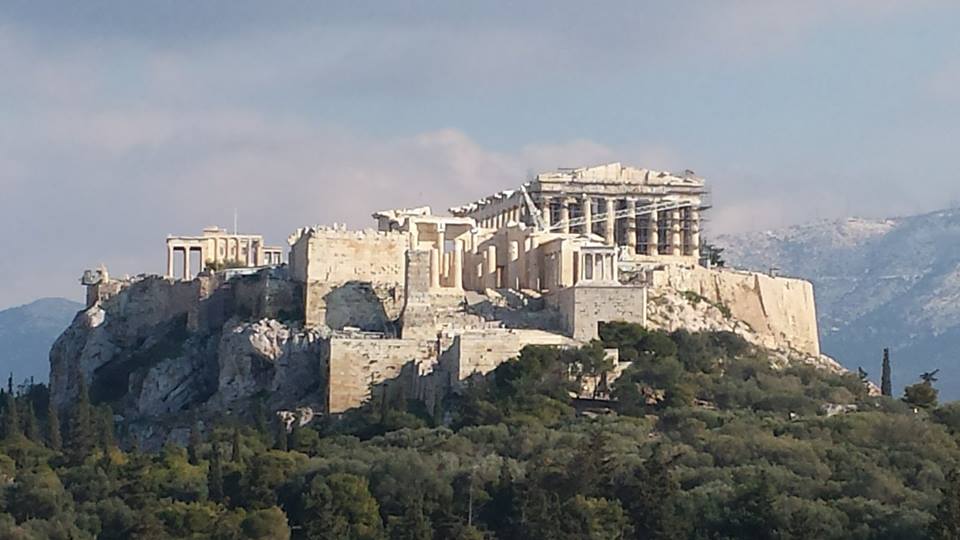
If you only have time to visit one attraction in Athens, this will have to be the world-famous Acropolis.
Literally meaning “the extremity of the city”, the Acropolis of Athens is a citadel containing what is left of several temples and other buildings built during the reign of Pericles, in the 5th century BC.
There were previously other temples and constructions in the area, none of which has survived.
Pericles was one of the most prominent statesmen of Ancient Greece, and Athens thrived during his reign. He promoted the arts and the idea of democracy to an unprecedented degree, and this period is largely referred to as the Golden Age of Pericles.
Greek Temples in the Acropolis
The most important temples and constructions that you can see today in the Acropolis site are the following:
- The Parthenon, a temple dedicated to the Virgin Goddess Athena (Parthenos = virgin), constructed between 447-432 BC. It was built on the site of an older temple dedicated to Athena, and is one of the most amazing temples of Ancient Greece. Several magnificent sculptures were used to decorate the friezes. Today, you can see models of the friezes and remains of the original statues in the Acropolis Museum and the British Museum in London.
- The Erechtheion, a temple dedicated to both Athena and Poseidon, built between 421-406 BC. At the Erechtheion you can see replicas of the famous Caryatids female statues, while the originals are kept in the Acropolis Museum.
- The Temple of Athena Nike, built around 420 BC in hope of victory in the Peloponnesian war which was ongoing between Athens and Sparta at the time (Nike = victory).
- The Propylaia, the massive entrance to the Acropolis, constructed between 437-432 BC but never fully completed. A giant bronze statue of Athena Promachos holding a spear and a shield was once standing behind the Propylaia. The statue was removed in the 5th century AD. It was possibly transported to Constantinople (Istanbul) later on, and eventually destroyed.
Damage to the Acropolis
Over the centuries, there has been a lot of damage to the ancient site of the Acropolis. Both a Christian church and a mosque were built inside the Parthenon Athens, only to be destroyed later on.
The most serious damage happened in 1687, when the Venetians bombed the site, causing the explosion of stored gunpowder and the destruction of several parts of the complex, especially the Parthenon.
The Elgin Marbles
In the early 19th century, Lord Elgin (Thomas Bruce) removed several sculptures from the Parthenon, and one of the Caryatids from the Erechtheion.
The original sculptures, known as the Elgin Marbles, can be found in the British Museum in London, while their replicas can be seen in the Acropolis Museum.
Allow a couple of hours to fully appreciate the Acropolis, and try to avoid the early morning hours, when most tourists visit from cruise boats.
Odeon of Herodes Atticus
This amazing theatre was built somewhere between 160-174 AD by Herodes Atticus, a prominent Athenian aristocrat and public benefactor, in memory of his wife. It is located right next to the Acropolis.
The Odeon of Herodes Atticus originally had a capacity of 5,000 people, and was used mostly for musical performances. It was destroyed during the Herulian invasion in 267 AD.
Much of the theatre was restored in the 1950s, and has been used ever since for performances and concerts.
It is only open during the summer months, usually May to October, and is home to the Athens Festival and other events.
It can only be visited during performances, and is a very special venue, so make sure you include it in your list of things to do in Athens.
Theatre of Dionysus
The Theatre of Dionysus sits right underneath the Acropolis in Athens. It was built in the 4th century BC and is considered to be the world's first theatre, with a capacity of around 17,000 people. There is evidence that earlier performances were held in the site of the Ancient Agora.
The city Dionysia festival, dedicated to Dionysus, the god of wine and drama, was held in the theatre. Ancient Greece’s most prominent dramatists, Aeschylus, Sophocles, Euripides and Aristophanes, wrote plays that were performed in this theatre.
The area was also used for the famous Assemblies of Athens, after Pnyx was deemed unsuitable. Performances were also held during the Roman era, especially under the reign of the Emperor Hadrian.
Parts of the theatre were originally made by wood, and were replaced by stone during the period of the Athenian statesman Lykourgos (390 – 325 BC). The complex seems to have been destroyed before the Byzantine era.
The Theatre of Dionysus was excavated during the 19th century. The remains that can still be seen today are mostly parts of alterations and restorations that took place in the Hellenistic and Roman eras.
Your ticket to the Acropolis allows you to visit the theatre of Dionysus.
Find out about tours to the Acropolis here: Acropolis Guided Tour.
Read more: Interesting facts about the Acropolis.
Temple of Zeus

The Temple of Olympian Zeus is a massive temple located a 15 minute walk from the Acropolis. It was built to honor Zeus, the most powerful god, known in Greek as Dias.
The temple, also known as Olympieion, was built over several centuries. It was completed in the 2nd century AD, during the reign of the Roman Emperor Hadrian, who also commissioned several other projects in Ancient Athens.
At the time of its construction, the Olympieion was the largest temple in Greece. Most of the original 104 columns were later destroyed or looted in order to reuse the material for byzantine temples and other constructions.
Nowadays, fifteen columns are still standing and one is lying broken on the ground. Similarly to Athena’s statue in the Acropolis, a gigantic statue of Zeus, made of ivory and gold, had once been erected in the site.
In the Olympieion site you can see remains of a few more monuments, such as the temple of Apollo Delphinios and the gates of the Themistoclean Wall.
Allow an hour in your Athens sightseeing itinerary to visit the site. If you are a fan of photography, watch out for the views of the Acropolis as you are walking around – you can take snapshots of both the temple of Zeus and the Parthenon.
Hadrian’s Arch
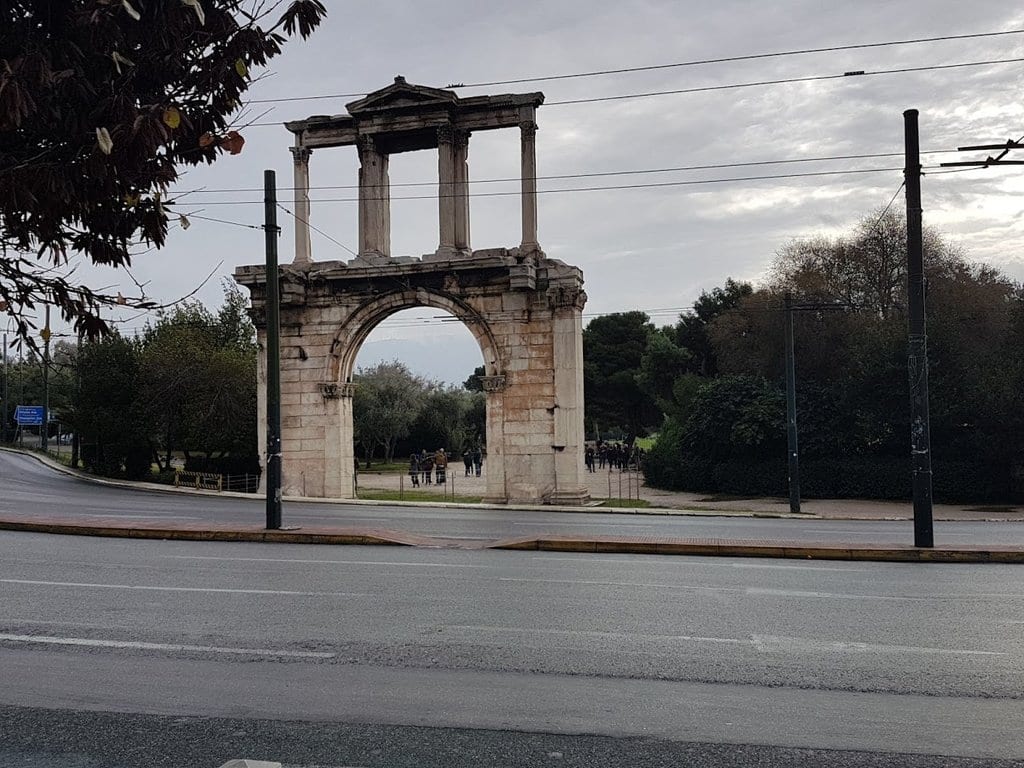
Just outside the site of the Olympieion, you can see the grand Hadrian’s Arch, built by the Athenians in 131 AD, to honor the Roman emperor Hadrian.
On the arch, there are two inscriptions, one describing Athens as “the ancient city of Theseus”, and one describing the city as “the city of Hadrian and not of Theseus”.
It has been suggested that the Arch was built on top of the Themistoclean Wall, but this view has later been debated.
It is worth making a special mention to the Emperor Hadrian (76 – 138 AD). He was probably born in today’s Spain, though in his now lost autobiography he claimed he was born in Rome, possibly to prove that he was a true Roman.
Hadrian travelled a lot around the Roman Empire, and built several defensive walls, including Hadrian’s Wall in today’s Britain, as well as several other constructions.
He was a philhellene, and commissioned several projects in Athens during his reign, such as the Hadrian’s aqueduct, several fountains, and Hadrian’s library.
Ancient Agora

If you only have time for one more ancient site in Athens apart from the Acropolis, make sure you visit the Ancient Agora of Athens.
This public area used to be the heart of ancient Athens for several centuries.
It was the centre for all social activities in the city, from administrative and commercial, to cultural, political and religious. This was where people came to shop, discuss and hang out in general.
The Ancient Agora was home to several ancient Greek temples, of which the best preserved one is the temple of Hephaestus. It is also known as Thisseion, because at some point it was believed that it was dedicated to King Theseus.
Another prominent building in the Ancient Agora is the Stoa of Attalos, which was fully reconstructed in the 1950s to host the Agora museum.
Agora History
The site of the Agora was gradually abandoned with the rise of the Byzantine Empire, and was redesigned as a residential area.
In the late 19th and early 20th centuries, when the site was first excavated, over 400 buildings that had been built on top of the grounds had to be demolished. Excavations are ongoing to the present date.
Apart from the ancient temples, the Agora also contains remains from the Byzantine era, the most famous one being the Church of the Holy Apostles.
Visiting the Agora in Athens
Allow at least a couple of hours to visit the Agora in Athens, and make sure you also visit the museum, in order to get an idea of life in Ancient Greece.
The entrance to the Ancient Agora is on Adrianou Street, and the closest metro station is Monastiraki.
Kerameikos
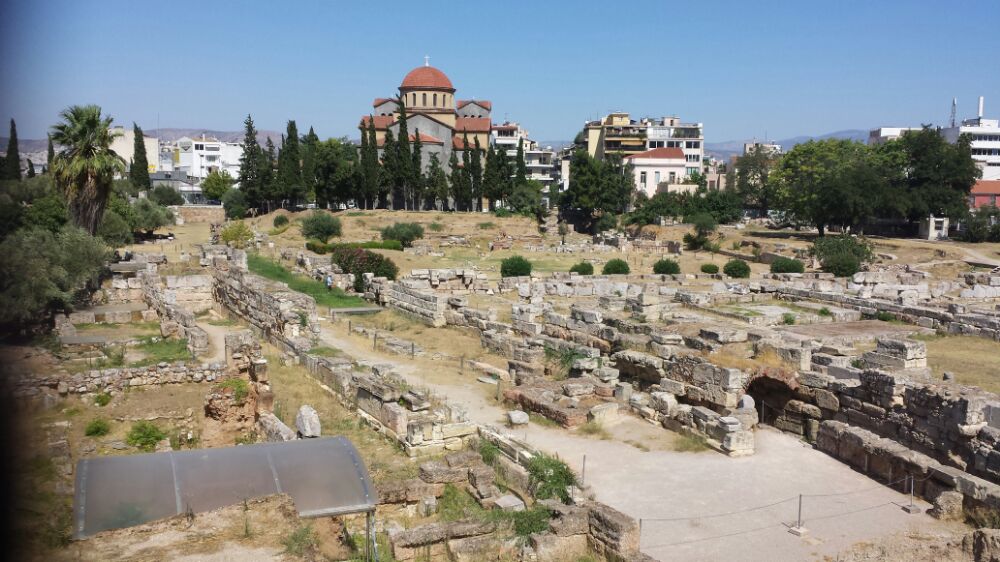
The ancient site of the Kerameikos was once a potters’ settlement, and the area where the famous Attic vases were produced. The site was gradually converted into the biggest cemetery of ancient Athens, hosting tombs from around 2700 BC until around the 6th century AD.
There is a small museum on the site, hosting vases, tombstones and other artefacts discovered during the excavations. The site also contains parts of the Themistoclean Wall. The remains of the Dipylon Gate, which led to Plato’s Academy, and the Sacred Gate, which connected Athens with Eleusis, can also be seen here.
You can read more here about the Kerameikos Site and Museum.
To get to the Kerameikos ancient site, you can walk from either Monastiraki, Kerameikos or Thisseio metro stations.
Roman Agora
The Roman Agora was built between 19 and 11 BC, and was refurbished during Emperor Hadrian’s reign.
After the Herulian invasion in 267 AD, it became the main commercial and administrative hub of Athens, replacing the Ancient Agora. A basilica and the surviving Fethiye mosque were constructed in the Byzantine and Ottoman periods, respectively.
In later periods, several buildings were built on top of the ancient ruins. They were demolished when excavations started in the 19th century, alongside with the excavations for the Ancient Agora.
The Roman Agora has two entrances, on the east and west sides. Within the premises, visitors can see the remains of the Agoranomion and the public latrines.
What attracts most people to the Roman Agora, however, is the newly restored Tower of the Winds. This octagonal tower combines a sundial, a water clock and a wind vane, and is considered to be the first meteorological station in the world.
The monument is also known as Horologion of Andronikos Kyrristos, or simply “Aerides” (Winds).
The Roman Agora is very close to Hadrian’s Library, near Monastiraki metro station.
Library of Hadrian
Emperor Hadrian commissioned this building in AD 132. It served as a library, with adjacent reading rooms and lecture halls.
It is estimated that 18.000 – 20.000 papyrus rolls were kept in the library before it was destroyed in 267 AD, during the Herulian invasion.
During the Byzantine era, three churches were erected in the premises, but were subsequently destroyed. The last of them was the first cathedral of Athens, known as Megali Panagia, built in the 12th century and burnt down in 1884.
The site became the seat of the Voevode (Turkish Governor) until 1835, when the barracks of king Otto were erected in its place.
Hadrian’s Library is located right outside the exit of Monastiraki metro station.
Areopagus

Areopagus, or Areios Pagos, is a popular spot, where you can get great views of the Acropolis. You can describe it as either a small hill or a big rock, and you can go up in just a few minutes. It is located close to Thisseio metro station, the Acropolis and the Ancient Agora.
Before the 5th Century BC, Areios Pagos used to be home to the Council of Elders. It gradually became the court of justice for most important cases, such as murders, treachery, sacrilege, fraud, bribery and destruction of public property. Later on, its role was limited to cases of murder, poisoning, arson and destruction of the sacred olive trees in Athens.
In 51 AD, Apostle Paul delivered his famous speech on Christianity from the top of Areios Pagos, converting two people – Dionysios Areopagitis, who later became bishop of Athens, and a lady named Damari, who later martyred for her faith.
Across the street from Areios Pagos, there is a large green area overlooked by most visitors, comprising three semi-distinct hills: the Nymphs Hill, Pnyx and Filopappou.
Nymphs Hill
The Nymphs Hill was dedicated to the Nymphs, the ethereal creatures. According to legend, the Nymphs had the power to conquer nature, as well as the souls of mortals. After Christianity prevailed, the concept of the Nymphs somehow survived, unlike that of the Olympian gods.
On the Nymphs Hill you can find the National Observatory of Athens, which was built in 1842 and is the oldest research institute in the Balkans. Today it comprises five institutes and has astronomical stations that facilitate research with continuous seismological observations. The Observatory can be visited upon request.
Pnyx Hill
The Pnyx Hill, located opposite Areopagus and right next to Nymphs Hill, is a green hill overlooked by most visitors. It is great to walk around if you want to avoid the crowds.
In Ancient Greece, Pnyx was the area where the Athenians hosted their popular Assemblies. All famous politicians and orators delivered their speeches on Pnyx.
The Hill was just outside the city, but its proximity made it ideal to organize gatherings. Views to the Ancient Agora and the Acropolis are superb, and they have been said to inspire speakers in Ancient Greece.
The principles of democracy were followed during the Assemblies – equality under the law, equality to vote and be elected, and equality / freedom of speech.
A two-meter thick defense wall was built in the 4th century BC to protect the Pnyx, joining up with the Themistoclean Wall.
The ancient Greek astronomer, Meton of Athens, made his observations from the top of the Pnyx. The foundations of his observatory can still be seen on the hill. Meton’s calendar has been used in the construction of the Antikythera mechanism.
Filopappou Hill
The Filopappou Hill, known as the Muses Hill in antiquity, is located close to the Acropolis, on the opposite side of Dionysiou Areopagitou Street, adjacent to the Pnyx.
Its current name comes from the Filopappou Monument, which is built on the top of the hill. Filopappos was a Roman philhellene who was proclaimed citizen of Athens at the end of the 1st century AD.
The Filopappou hill covers a large area, and is ideal for walking or running. It is a popular spot for Athenians, and the views are superb. It is best avoided at night, as a few incidents have been reported.
Choragic Monument of Lysicrates
The Choragic Monument of Lysicrates is the best preserved choragic monument of antiquity, and is located in Lysikratous square in Plaka Athens. It was erected by Lysicrates, a sponsor of musical performances in the Theater of Dionysus, to showcase his award to one of the performances he had sponsored in 335/334 BC.
The monument is made of limestone and marble, and the award, which was a bronze tripod, was placed on top. In the 17th century, the monument was incorporated into a Capuchin monastery, and was used as a reading room and library.
The monastery was destroyed in 1824. The Choragic Monument of Lysicrates has been preserved, though the award has sadly not survived.
Themistoclean Wall
The Themistoclean Wall was built in 479-478 BC, to protect the city of Athens from invasions. It was named after its creator, Themistocles, a prominent Athenian politician and general.
The Themistoclean Wall stretched for around 6.5 kms, was 8 meters high and 2.5 meters wide, and had at least 13 gates, two of which are in the Kerameikos area. At a later stage, a moat was constructed outside the wall, which was 4 meters deep and 9-12 meters wide. The wall was partly destroyed, rebuilt and restored several times over the next centuries.
The Themistoclean Wall passed through the areas of Kerameikos, Nymphs Hill, Pnyx, Filopappou Hill, Dionysiou Areopagitou Street, Hadrian’s Arch, Syntagma and Peiraios Street.
Some of the remains are still visible today, while others can be found underground, in modern buildings. The best preserved part of the Themistoclean Wall stretches for around 200 meters and can be found at the Kerameikos area.
Panathenaic Stadium

The Panathenaic Stadium was built around 330 BC, by the Athenian statesman Lykourgos, to host the Panathenaic and other Games. It was restored by Herodes Atticus in the 2nd century.
This stadium is the only one in the world that is constructed entirely by marble. It was largely abandoned after the 4th century, with the rise of Christianity.
The stadium was excavated in 1869, and was restored and refurbished to host the first modern Olympic Games in 1896.
Since then, it has hosted several events, such as concerts and ceremonies relating to the Olympic Games, Marathons and other sports activities.
You can read more here about visiting the Panathenaic Stadium in Athens.
Byzantine Athens
For the sake of this guide on what to see in Athens, I’ve defined the Byzantine era as lasting from 330 AD to 1458. Although technically speaking, there were other conquerors during this period, they left little of note behind.
One structure which is most noteworthy was the Frankish Tower built in the middle ages on the Acropolis. This was demolished in 1874 though.
Byzantine Churches in Athens
After a period of being semi-deserted, Athens became once again an important art and trade centre during the Byzantine era. The area of the Ancient Agora was built over, and the town grew outside the area of the ancient Greco-Roman walls.
Most of the Byzantine churches that still remain today were built during the 11th and 12th centuries, when the city reached a new height of growth.
Many of those churches were built outside the city centre, close to the coastline and also at Penteli and Koropi areas.
The most famous Byzantine churches outside the centre are the Dafni Monastery in Egaleo Area, a UNESCO World Heritage Site, and the Kesariani Monastery, on mount Imittos.
While walking around central Athens, you are likely to come across the following Byzantine churches:
Church of Virgin Mary / Panagia Kapnikarea
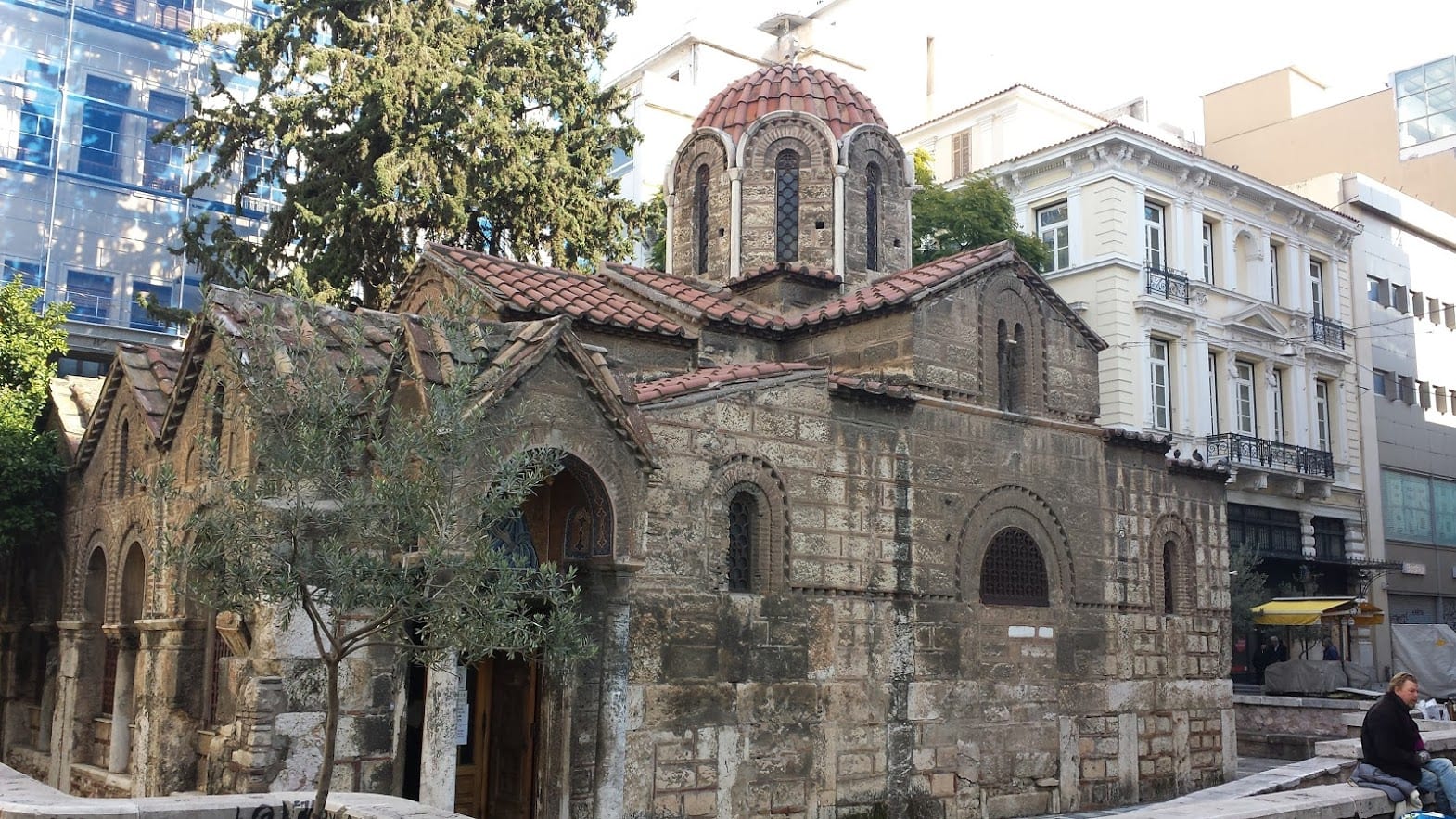
Right in the middle of the pedestrianized Ermou Street, you can see Kapnikarea church, the main part of which was constructed in the mid-11th century and was dedicated to Virgin Mary.
Like most Byzantine churches, it was erected over the remains of an ancient temple, most likely dedicated to either Athena or Demeter.
The church is in fact a complex of three distinct temples, built in different periods. The frescoes in the interior are more recent.
When Greece regained its independence from the Ottoman Empire, and during the reconstruction of the city, it was suggested that the Kapnikarea church be demolished, but luckily this plan never came to fruition.
Old Metropolis / Church of Virgin Mary Gorgoipikos – Agios Eleftherios
Blink and you’ll miss it – this magnificent church is right behind the grand Metropolis of Athens, just off Mitropoleos street, but is often overlooked by visitors as it is overshadowed by the big Cathedral.
It was built in the 12th century and served as the seat of the Orthodox Diocese. The frieze at the front was constructed in the 4th century BC and was originally part of an ancient temple.
If you look closely, you will see that sculptures from different eras have been incorporated in the façade.
(The Metropolis of Athens, the modern, more impressive Cathedral next to the small Byzantine church, was constructed in the 19th century. It underwent excessive restoration which ended in 2017-2018, and is one of Athens’ main cathedrals).
Church of Holy Apostles / Agii Apostoli
The Church of the Holy Apostles is located within the area of the Ancient Agora. It was built in 1000-1025 AD, on top of the ruins of a Roman nymphaeum built in the 2nd century. Its architecture is pretty unique, combining elements from different architectural styles.
Russian church / Church of Sotira Likodimou
This stunning temple on Filellinon Street was built in the early 11th century, on top of the remains of a temple dedicated to Apollo, and an area of Roman baths.
Over the years, it functioned successively as a nunnery, a Benedictine monastery and an Orthodox monastery.
It was semi-destroyed multiple times over the centuries, and was eventually restored with the aid of the Russian Orthodox community in Athens.
Underneath the church, there are catacombs, where remains of the ancient Roman baths can still be seen – unfortunately, the catacombs are generally closed to the public.
Panagia Pantanassa, Monastiraki square
Few tourists will not pass by Monastiraki square, yet extremely few people visit this lovely church, dedicated to Virgin Mary.
The Pantanassa was most likely built in the 10th century, which makes it one of the oldest churches in Athens.
Later on, it functioned as both a male and a female monastery, which is why the wider area was named “Monastiraki”, meaning “Small monastery”.
The last monastery was closed down in the late 1600s. A big mass takes place on 15th of August, when the Dormition of Virgin Mary is celebrated around Greece.
Agios Dimitrios Loumbardiaris, Filopappou Hill
If you climb up Filopappou Hill, make sure you visit this small church right off the path going up the hill.
Opinions differ as to when it was built – it may have been as early as the 9th century AD, but it was most likely built during the Ottoman era.
The church incorporates several ancient Greek elements. During its restoration in the 1950s, superb frescoes were discovered.
The church is extremely popular for weddings, so if you are in Athens during a weekend, try to visit on a Saturday evening and enjoy people-watching.
Byzantine churches in Plaka area
There are several byzantine churches in Plaka area, some of which are better preserved than others.
- Church of Agia Ekaterini – It is close to the Choragic monument of Lysicrates, and was built in the 11th century. Unfortunately, not all of the later enhancements and restorations were entirely successful.
- Church of Agios Ioannis Theologos – In this 13th century church on Erectheos Street, you can see some of the original murals and frescoes on the walls. The church is generally closed to the public, but can be visited on the 8th May when there is a mass.
- Church of Metamorfosi Sotiros – This elegant temple on Klepsydras street was built in the 11th century. It is only open to the public on 6th August every year. One of the most prominent leaders of the Greek Revolution, Odysseas Androutsos, has been buried in the courtyard.
- Church of Agios Nikolaos Ragavas – This church, located on Prytaneiou Street, was built in the 11th century. There were significant alterations of questionable quality in the 19th century, but most of them were fortunately restored in the 1970s.
Ottoman Athens
Athens finally fell to the Ottoman empire in 1458. A period of decline followed, and it’s unclear whether Athens was intentionally stripped of its importance, or it happened as a by-product of bad administration.
The population of Athens was reduced dramatically, and even in the 1700s, English visitors recorded populations not exceeding 10,000 people.
Ottoman Era in Athens
During the Ottoman period, the city changed a lot. Mosques were built inside the Byzantine and surviving ancient Greek temples, and several other buildings, such as hammams and Muslim cemeteries, were constructed. A wall was also erected in 1778, but it was later destroyed.
Given that excavations that took place in the 1800s and 1900s prioritized the restoration of Greece’s ancient past, it is hardly surprising that evidence of Ottoman buildings is scarce, especially to the untrained eye.
Among the few buildings that remain from the Ottoman era, the following are the most important:
The family mansion of Benizelos – Palaiologos, Adrianou Street, Plaka
This residence is one of the oldest surviving houses in Athens Greece, built in the beginning of the 18th century. It opened to the public in recent years, after a long restoration period.
It has been transformed into an interactive museum, where the visitor can experience life of the city’s nobility during the Ottoman era.
The mansion has two storeys. On the ground floor, visitors can see the warehouse rooms, where food and goods were stored.
On the first floor, there are the bedrooms and all common rooms that were used by the family. Underneath the building, ruins of the Roman Wall have been discovered.
The most important characteristic of these wealthy houses of the era was their autonomy: the spacious courtyard which had a fountain and a well, and the presence of wine and olive presses.
One of the most famous residents of the Benizelos mansion was Rigoula Benizelou, a lady who was led into a forced marriage very early in her life. After her husband’s death, she became a nun, and eventually founded St Filothei Monastery close to her home, aiming to help poor women.
The Bathhouse of the Winds, Kyrristou Street, Plaka
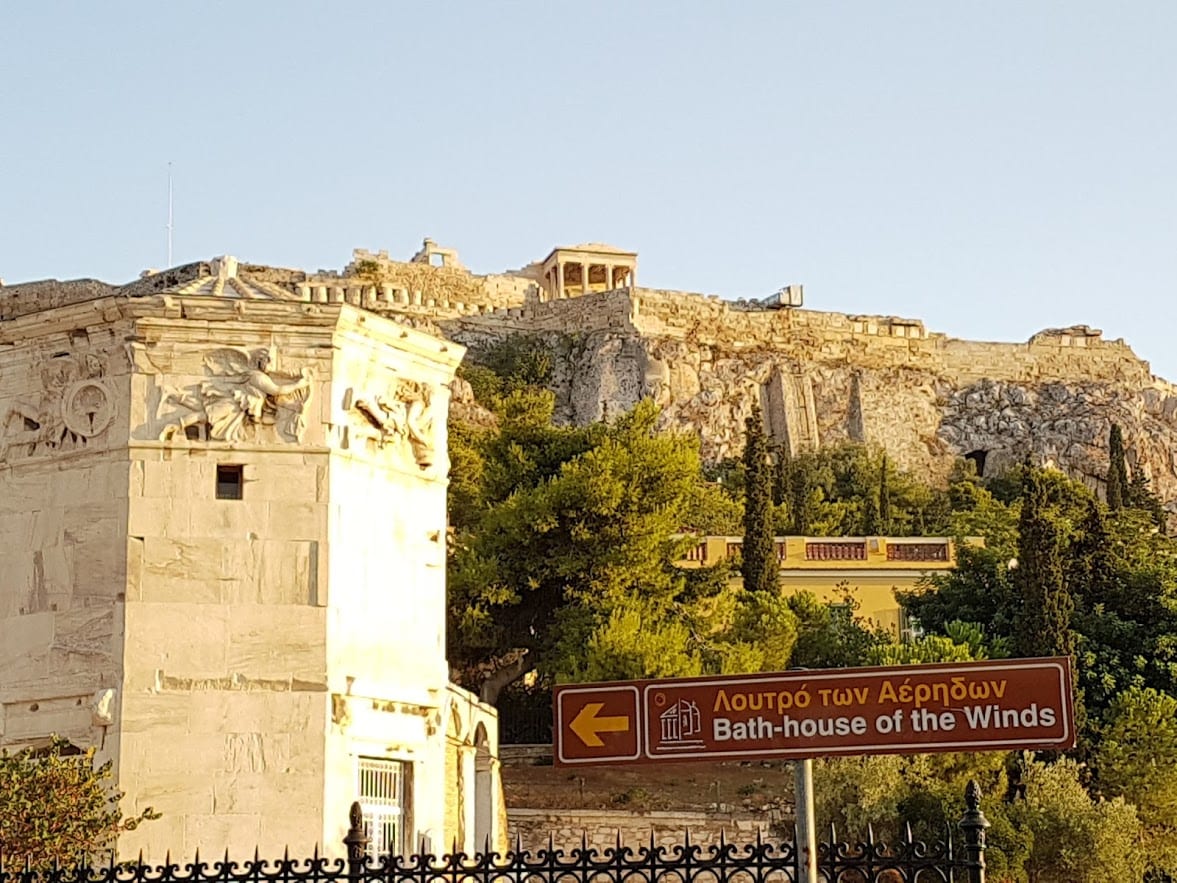
The only surviving hammam in Athens, this bathhouse was constructed in the 15th century. It borrowed its name from the nearby Tower of the Winds, in the Roman Agora.
In Muslim culture, the hammams were a place that everyone should visit twice a week, and there was a whole ritual behind their function. They were also an important meeting place, where discussions (and gossip) were had and secrets revealed.
This hammam was built along the lines of a typical Ottoman hammam, with three separate areas – a waiting room, a warm room, and a hot room, where temperature reached 35-40 degrees.
After the end of the Ottoman era, the baths were transformed to mixed baths, serving both men and women simultaneously, and operation continued well into the 1960s. Today, the site is used as a museum, and exhibitions are often organized.
Tzistarakis Mosque, Monastiraki Square

This grand mosque was built in 1759 by the Turkish voivod at the time. One of the surviving columns of the Olympieion was used in its construction.
The building was restored in the 20th century. It used to house the Museum of Traditional Ceramics, which has been closed to the public for years.
Fethiye Mosque, close to Monastiraki Square
The Fethiye mosque, which is very close to the Roman Agora, was built in 1457, on top of the ruins of an earlier Byzantine church. It was brought to the ground and subsequently rebuilt in 1668.
After Greece regained its independence, the minaret was destroyed. Since then, the mosque has had various uses, among which a school, a prison, a military bakery and an archaeological warehouse.
Today, cultural events and exhibitions are held here from time to time.
The Monastiraki market area
For most visitors, the maze of streets around Monastiraki metro is difficult to navigate through. To a certain extent, this is the result of Turkish urban planning during the Ottoman era.
A bazaar was held in the wider area, dominating the grounds of the Ancient Agora, and has continued to the present day.
During the Ottoman era, the market stretched from Hadrian’s library all the way to the temple of Ifestos, inside the Ancient Agora, and to the Psirri neighborhood.
Just like the Ancient Agora, the Ottoman market was the commercial centre of the city, with produce, household goods and pretty much everything else being sold, but also where political and social debate arose. Very few women visited the bazaar.
After a big fire in 1884, when the bazaar was destroyed, the produce market was moved to Athinas street, where it still stands today and operates from Monday to Saturday, having partly lost its social character.
At the same time, today’s flea market on Ifestou Street and around is popular with locals and visitors alike. This market is open every day, and is larger on Sundays.
Neoclassical Athens
Following the Revolution against the Ottoman Empire in 1821, Greece became an independent country in 1830, and Athens was declared its capital in 1834.
At the time, Athens was home to no more than 10,000 people, and had no relevance to the bustling city that it is today.
The 17-year-old King Otto from Bavaria assumed Greece’s throne in 1832. Among his other tasks, he assigned the urban redevelopment of Athens to the architects Stamatis Kleanthis, Gustav Eduard Schaubert and the von Klenze brothers, with strict instructions to care for the city’s ancient history.
During this period, architects from several countries were commissioned to design and overview the construction of new buildings in Athens. Today, we call these buildings neoclassical.
The Parliament / Old Palace

Probably the most visited neoclassical building in Athens, the Parliament building right on Syntagma square was originally King Otto’s Palace.
It was designed by the German architect Friedrich von Gärtner, and constructed between 1836 and 1847.
Since 1929, this impressive building has been home to the Parliament of Greece. A visit inside the Parliament can be arranged well in advance. It’s advisable to visit with someone who can speak Greek, as there is no information in English.
In front of the Parliament, you can see the change of Guards / Evzones every hour, on the hour. This space is also home to the Tomb of the Unknown Soldier, so be respectful when you visit.
Adjacent to the Parliament, you will find the city’s National Gardens. These were originally designed and maintained under the suggestions of Queen Amalia, King Otto’s wife.
Zappeion Megaron
Inside the National Gardens, you can find the Zappeion mansion. This was the first building in the world specifically constructed to host modern Olympic Games.
It was designed by the Danish architect Theophil Hansen, and its construction was completed in 1888. Today it is mostly used for exhibitions, meetings and ceremonies.
The Museum of the City of Athens

This largely overlooked museum close to Syntagma Square was King Otto’s and Queen Amalia’s first home, before the Parliament was completed.
The Museum of the City of Athens hosts some of the Royal couple’s furniture and other belongings. It’s worth visiting, if only to have a short stop at the adjacent Black Duck garden café.
Grande Bretagne Hotel
Right on Syntagma square and across the street from the Parliament, this superb building was completed in 1842. It was designed by Theophil Hansen and was originally a private mansion, belonging to a rich Greek from Trieste.
Although it was smaller than the Palace, it has been described as more luxurious. If you are not lucky enough to be staying in the hotel, (one of the best hotels in Athens), you can always enjoy a meal, drink or tea on their wonderful terrace.
Buildings on V. Sofias Street
At the start of Vasilissis Sofias Street, between Syntagma Metro Station and Evangelismos station, you can see several neoclassical buildings.
Walking up from Syntagma towards Kolonaki area, you can see the Embassy of Egypt, the Ministry of External Affairs, the French Embassy, the Theocharakis Foundation, the Italian Embassy, the Benaki Museum, the Cycladic Art Museum and the Byzantine and Christian Museum.
These buildings were originally constructed to be private mansions, and were later donated or acquired by the respective foundations. Many of them were designed by the famous architect of the times, Ernst Ziller.
There used to be many more neoclassical buildings in that area of the city. Sadly they were demolished in later years and replaced with modern buildings.
The Numismatic Museum / Iliou Melathron
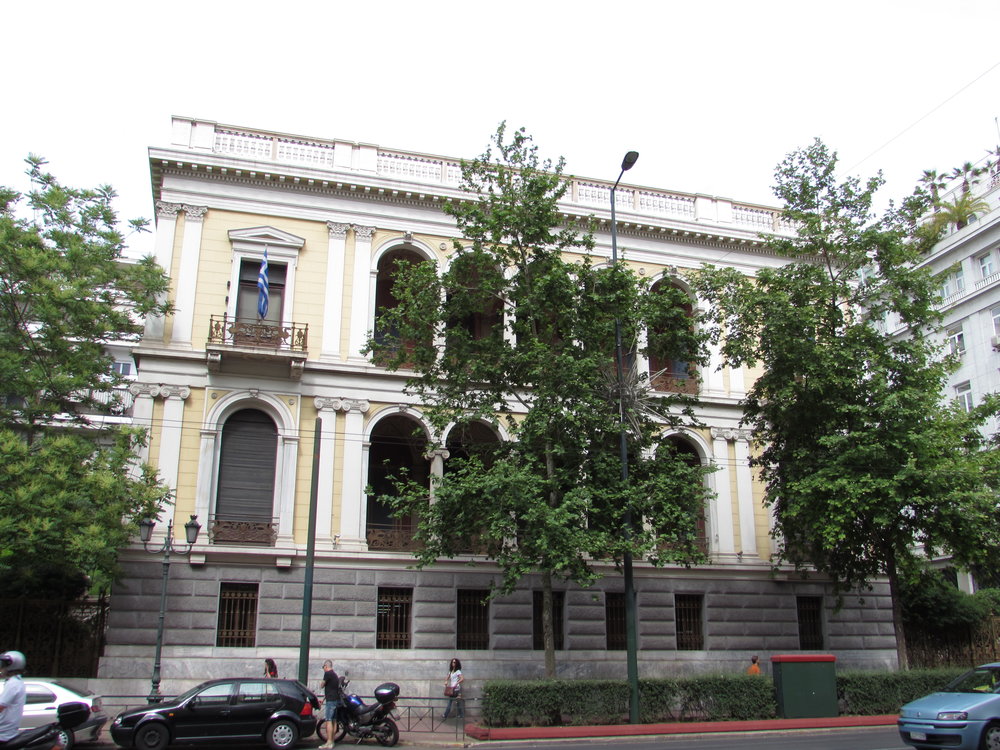
This exquisite building designed by Ernst Ziller, was originally the house of the prominent archaeologist Heinrich Schliemann. This is the man who became famous for excavating Troy and Mycenae.
It is now home to the Numismatic Museum, and the garden is a lovely spot away from the noisy city, hosting live gigs on hot summer nights.
The Athens Trilogy
Popular among visitors, these three buildings right outside Panepistimio metro station, namely the National Library, the University of Athens and the Academia of Athens, were designed by the Hansen brothers and Ernst Ziller in the style of ancient Greek temples, notably the temple of Ifestos and the Erectheion.
The three buildings were completed between 1839 and 1902. The National Library was in full operation until recently, when the books were transferred to the newly constructed Niarchos Foundation Cultural Centre. The University building is still in operation, mainly for ceremonies and other events.
The Anafiotika houses
One of the most charming neighborhoods of central Athens, the Anafiotika right on the foot of the Acropolis is a haphazard collection of hastily built houses, similar to the white houses of the Cyclades islands.
They were constructed shortly after Greece won its Independence to host builders and other workers, and were mostly built illegally and during night time.
While strictly speaking the Anafiotika houses are not neoclassical buildings, the area is absolutely worth a visit – just be mindful of the residents and respect their privacy.
Athens Greece Landmarks
Now, you somehow need to plan a way to see it all! Check out my guide on how many days to spend in Athens. All seems too much? Check out a private tour of Athens! And if you are a fact collector, read this trivia guide to facts about Athens in Greece.
Did you enjoy this article on Athens monuments and what to see in Athens? I'd appreciate if you could share it.
If you're a Pinterest user, I've included an image below. It would look great on one of your boards dedicated to travelling to Athens Greece.

Wow! This is why I love Athens. The buildings look so stunning! I can’t even imagine how many people the Panathenaic Stadium would accommodate. Thanks for sharing this. I’m saving it as a reference.